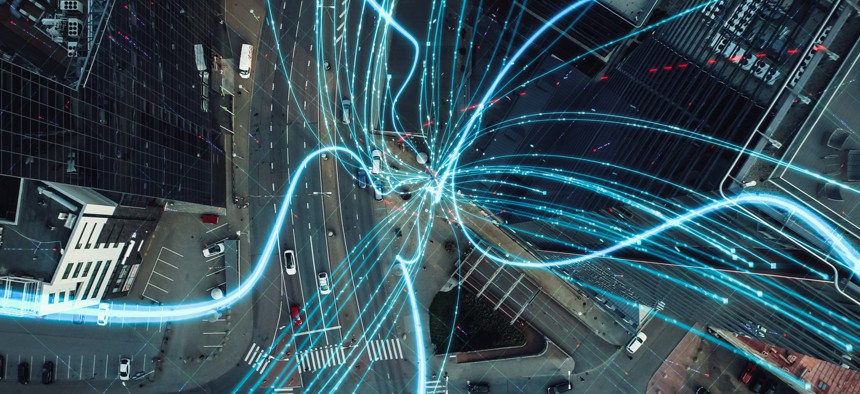Intelligent, adaptive emergency response built on AI and 5G

gorodenkoff/Getty Images
Layering 5G with various forms of artificial intelligence can enable a network topology that’s situationally aware—intelligent enough to automatically and rapidly sense and evolve with changing conditions.
The United States saw 22 separate billion-dollar climate disasters in 2020, a record. The following year came in second, with winter storms across Texas and the deep south; wildfires across California, Arizona, Colorado and other states; numerous severe, off-season tornadoes; and multiple tropical cyclones, including Ida, Elsa and Fred.
Compounding those threats is America’s aging critical infrastructure. In 2021, the American Society of Civil Engineers gave the nation’s infrastructure C and D grades in 16 categories, including energy, roads, bridges, dams, levees, drinking water and wastewater.
When disaster strikes or infrastructure fails, people—sometimes entire city populations—can be at risk for injury, illness or death. Rapid, coordinated response is imperative to minimize damage, restore services and prevent harm.
Pivotal to that response is reliable communication. Yet communication equipment is also at peril in the face of natural disasters and infrastructure failures. How do officials keep first responders and citizens connected and informed when the network itself is offline?
One promising answer is an ingenious combination of 5G communications, various forms of artificial intelligence and other advanced capabilities. The technologies and techniques are already available. Innovative government organizations are beginning to explore the disaster-mitigating, emergency-moderating possibilities.
5G, meet AI
Fifth-generation, or 5G, cellular networking has improved the speed, responsiveness and usefulness of mobile communications. Layering 5G with various forms of AI can enable a network topology that’s situationally aware—intelligent enough to automatically and rapidly sense and evolve with changing conditions.
For instance, the Department of Defense could combine 5G and AI to enable the military’s cellular network to seamlessly connect its various operating environments on the battlefield. The network would have the intelligence to dynamically modify its own topology to remain secure and resilient, while making data sharing safer and more reliable. That would enable faster, smarter decision-making in situations where speed and accuracy are paramount.
The same basic concepts apply in disaster and emergency situations. The result would be a purpose-built emergency 5G network that acts as a holistic, adaptive organism. It would continually sense changing conditions, intelligently enable information to flow where it’s needed and empower both victims of and responders to disaster to take the right actions at the right times.
There’s a drone for that
In disasters like wildfires, tornadoes, hurricanes and earthquakes, it’s not unusual for cell towers to become damaged, disrupting connectivity. In these cases, telecom providers or responders such as the Federal Emergency Management Agency can bring in cells on wheels (COWs). But these trailer-mounted tower replacements can take hours or days to deploy, and in mountainous or forested areas, they’re not always viable.
One solution would be to deploy 5G-equipped, AI-enabled drones as airborne, adaptable cell towers. Machine learning and simplified AI heuristics can intelligently follow first responders, rescue vehicles and related equipment to maintain cell service wherever it’s needed. These capabilities can detect and navigate around obstructions such as mountains, vegetation, smoke and severe weather. They can automatically heal the network if portions are newly damaged.
What’s more, AI can grow or shrink the network as needed or relocate it as people and equipment change locations. If a rescue team is in danger or its needs take priority over other users, the technology can optimize coverage to meet those requirements.
In other words, 5G and AI combine to create a network that’s context aware. The network can account for how many stationary and airborne cell towers are available, what their maximum range is, how much battery power they have in reserve, how weather conditions might affect those factors and so on.
5G, AI-equipped drones could even coordinate with AI-enabled equipment on the ground. For instance, AI might automatically manage power consumption to maximize battery life. Or it might automatically connect a rescue team’s smartphones to create a mini 5G network.
The technology to achieve these objectives is available today. In fact, at least one major telecom carrier has field-tested 5G-equipped drones in remote environments. AI models for these use cases will need to be trained, but that learning can start now in centralized locations and then be fine-tuned at the edge, in real-world conditions.
The innovative combination of 5G, AI, drones and other technologies promises to transform how government agencies and operators of critical infrastructure respond to emergencies. They can reliably and cost-effectively ensure that rescue and response teams maintain continuous communication. Ultimately, they can improve the safety of emergency victims and responders alike and optimize the outcomes of disaster response.
Leland Brown is a principal engineer and technical director of advanced communications for military, aerospace and government at Intel Corp.
Stan Mo is a systems architect in the Internet of Things Group for public sector programs at Intel Corp.





